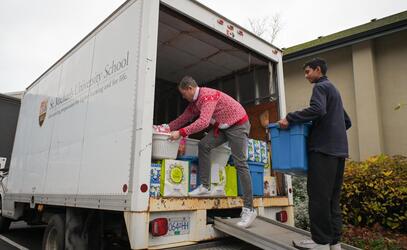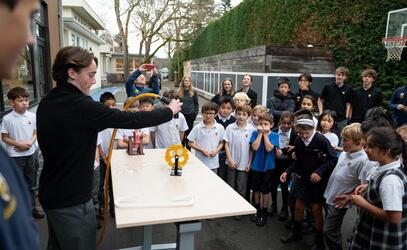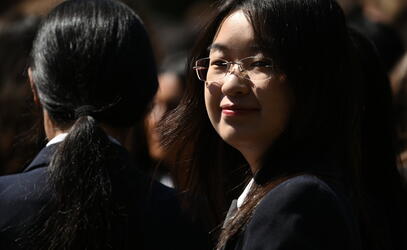"How many hours do you think the average person works a year?," Joseph Erlic '12 asks our Grade 3 students.
"30 hours?" Higher. "Maybe 150?" Even higher. "1,000?" Keep going. "2,000 hours?"
"That's right. The average person works 2,000 hours a year," Joseph says. "Now would you rather spend 2,000 hours doing something you found boring, or would you rather do something that you love; something that you're happy and passionate about?"
The Grade 3 students enthusiastically respond that they want to spend that time doing something they're passionate about.
"Exactly! I try to work 2,500 hours a year because I love what I'm doing so much," says Joseph, the inventor of HoopLight. Joseph and his brother Jure Erlic '10 founded HoopLight less than two years ago out of their own passion for basketball.
"For a university project they challenged us to come up with some sort of business idea. My uncle is a product designer and he told me that the No. 1 rule of product design is that it has to come out of something that you love to do," Joseph tells the students. "My cousins love basketball, too. They have a hoop outside and play into the night all the time, but the hoop just kind of disappears after a while. I thought, 'What could be an invention that would make their basketball experience so much better?'"
Joseph got to work and came up with a huge list of ideas – he says upwards of 500 of them – that could be done. One of them was the HoopLight.
HoopLight is a sensor-activated LED strip that attaches to a basketball hoop that constantly lights up the rim but also changes colours and patterns when you score a basket.
Design Thinking
Joseph and Jure recently visited our Junior School to speak with Grade 3 students about the design thinking process.
"We want students to hear about the process that a real inventor goes through because when they're in the Imagination Lab we ask them to go through a similar process and during the Grade 3 Genius Hour they're following their passions and trying to create new and interesting things," says Mrs. Alison Galloway, Grade 3 teacher and Design Thinking Coordinator.
The five phases of design thinking are: empathize, define, ideate, prototype and test.
Alison says the HoopLight story is the perfect example of this process to help inspire students.
"We always start with 'Who's our user? What do they need? What's a problem in the world we're trying to solve?' Then we try to figure out what is it specifically that they need. Then we brainstorm – ideate – as many different options, and then we start creating prototypes. After that you start testing and retesting," Alison says. "It was wonderful that Joseph has gone through the same design thinking process and was able to talk to the students using the same language that we use here in the Imagination Lab."
'You want to fail'
Joseph brought a few of the HoopLight prototypes and iterations to show the students how the product has been improved over and over in such a short amount of time.
The students asked thoughtful questions about going through the process of inventing a product, including asking about failure.
"Do you ever get discouraged?"
"Yeah, I do when customers get unhappy, but instead of being upset you just need to think of a way to make the customer happy. For product design especially, but anything you do in life, you're going to fail. That's completely OK. In fact, you want to fail as many times as you can in the shortest amount of time because you keep learning, and you keep getting better and better at what you're doing," he says. "I must've failed hundreds and hundreds of times with HoopLight, but when you fail you just brush it off and keep going. After you fail you do another iteration and another iteration until you fix every problem."
Students were also keen to learn about the technical side of HoopLight, asking questions about where they source the material, how the battery pack works and whether HoopLight could one day become solar powered.
"It was very inspiring to hear from someone who's gone to our school, gone through the journey of inventing something and actually created a product that they sell," Alison says. "I think the students were clearly inspired and will take what they've learned and put it into practice in their own work."


